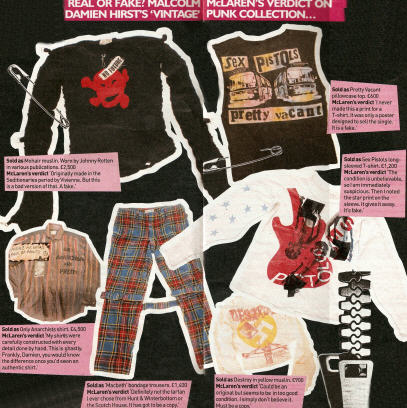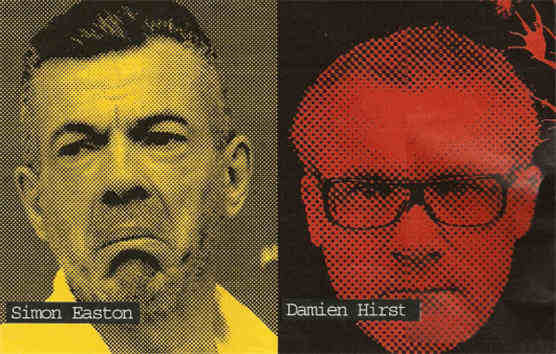
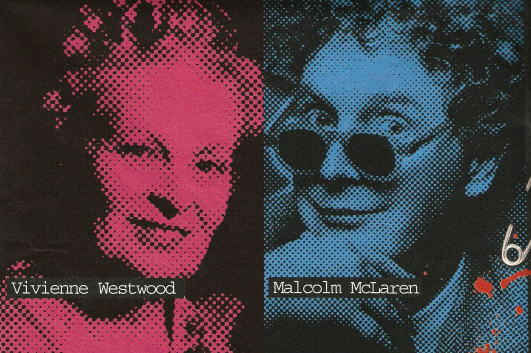
| REPORTAGE EVER GET THE FEELING YOU'VE BEEN CHEATED DAMIEN HIRST DOES. HE PAID £80K TO CLOTHES DEALER SIMON EASTON FOR A COLLECTION OF PUNK ERA VIVIENNE WESTWOOD CLOTHES, ONLY FOR MALCOLM MCLAREN TO LATER CONDEMN THEM ALL AS FAKES! KRIS HOLLINGTON ASKS, |
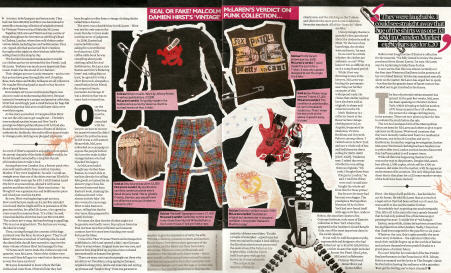
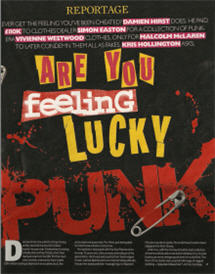
Damien Hirst, the world's richest living artist, stood in his new £3 million manor house near Cheltenham holding a badly
stained Sex Pistols shirt that had just cost him £4,500. For a man who recently claimed to have made £50 million selling a
diamond-encrusted skull, the price was mere pennies. For Hirst, just being able to hold it was a dream come true.
He had been obsessed with the Sex Pistols since he was 12 years old. Like so many schoolboys of his generation, Hirst
was seduced by their hard-edged music, radical fashion and uncompromising attitude. He saw the band and their
manager/guru Malcolm McLaren as demi-gods. He would have loved to have stepped into their shoes.
And now, with the money to build a vast collection of memorabilia and a mansion to display it in, he was buying up every vintage punk item he could find.
The floor of his studio was covered with bags of ragged clothing- ripped and bleached T-shirts, bondage trousers, holed jumpers and tartan suits. They
had cost him £80,000, but Hirst was determined to assemble a stunning collection of originals created by Vivienne Westwood and Malcolm McLaren.
Together, McLaren and Westwood ran a series of shops throughout the Seventies at 430 King's Road in Chelsea, London, where they sold clothes under
various labels, including Sex and Seditionaries. They cut, ripped, stitched and sewed their creations throughout the night on their kitchen table before
selling them in the shop by day. 'We decided we needed mannequins to model our clothes and so we invented the Sex Pistols: said McLaren. 'Fashion
was much more important than music. Punk was the sound of our fashion.'
Their designs are now iconic treasures - and so rare that prices have gone through the roof. Jonathan Ross, Kate Moss and Bobby Gillespie are all
collectors. No wonder Hirst had paid so much to buy his own slice of punk history.But modern art's most controversial figure was about to make an
embarrassing discovery. Because instead of investing in a unique and genuine collection, Hirst had unwittingly paid a small fortune for bags full of old
clothes that McLaren would later claim were worthless copies.
As the story unravelled, it transpired that Hirst was not the only one to get caught out - Christie's international auction house and New York's prestigious
Metropolitan Museum Of Art had also found themselves in possession of items of dubious authenticity. Suddenly, the multimillion-pound trade in vintage
punk clothing was plunged into crisis.
As word of Hirst's expensIve acquisition went round the gossip channels of the fashion and art worlds, he found himself contacted by a longiist of punk
aficionados keen to take a look. Among them was Camden Jim, a former punk who once sold replica shirts from a stall on Camden Market. 'They were
laughable: he said. 'I could see straight away that one of the shirts was one I'd sold in Camden eight years ago for £20. I told Damien I paid 60p for it at a
pound shop, altered it with some patches and then sold it on.' Hirst was furious - he thought it was a genuine Sex and Seditionaries piece and it had just
cost him £4,500. By now, Hirst was beginning to get anxious.
How could he have made such a terrible mistake? Convinced that he might still be in possession of the genuine articles, he called McLaren, who agreed to
come round to examine them. 'It's a fake: he said, when handed the shirt that had cost Hirst £4,500. 'The colours are wrong, the handwriting is appalling.
This is not an original shirt. The buttons are wrong, the label is wrong.' Then, rooting through the contents of the bags scattered over the floor, his shock
grew. 'They're all fakes!' McLaren screeched. If nothing else, he said, the alarm bells should have started to ring over the sheer volume of items Hirst had
managed to buy. 'Vivienne and I never made the clothes in any real quantity: says McLaren. 'Most of the clothes were worn until they fell apart or were lost
or thrown away, so very few have survived.'
McLaren demanded to know where the fake clothes had come from. Hirst told him they had been bought on eBay from a vintage clothing dealer called
Simon Easton. The news was a double blow for McLaren - Hirst was not the only man in the room that day to have made a serious error of judgment. In
2006, Easton had contacted McLaren, asking for a contribution to a luxurious, £250 coffee-table book he was compiling about punk clothing called Sex
And Seditionaries. McLaren says Easton sent him 'a flattering letter' and, taking him on trust, he agreed to write a short foreword, alongside a contribution
by his friend, the respected music journalist Jon Savage. It was a decision that was to come back to haunt him.
Over the following months, Hirst consulted with his lawyers on how to recover hiynassive losses (he didn't . contactthe police because he felt it was a civil
matter). Meanwhile, McLaren embarked on a campaign to expose the people behind the lucrative trade in fake vintage fashion who had hijacked his
legacy. As McLaren hadn't bought any clothes from Easton, he wasn't able to sue him directly for selling fake goods, so instead he set about trying to
have his foreword removed from Easton's book, claiming the clothes pictured 'were almost entirely fake'. He also wanted to encourage Hirst to take Easton
to court, telling him that he was 'more than prepared to testify for him'.
For some, the idea that the clothes might not be genuine was hardly news. Pop culture
historian Paul Gorman says that collectors and museum curators have for years been
handing over small fortunes for fakes.
'I was at the V&A Vivienne Westwood retrospective exhibition in 2004 and spotted a fake:
says Gorman. 'They're everywhere. Original items are very rare, and sources have long
dried up, so prices have rocketed internationally as demand has grown.
'There are many unscrupulous people out there who are akin to art fraudsters, using
ageing techniques, original-looking yarns, labels and materials and mixing up phrases
and "handwriting" from one garment to another to give the impression of rarity,' he adds.
'Private collectors, museum curators and auction-house buyers have shown their
ignorance of the subtleties, and the fakers out there have taken advantage. There are
some professionals and academics who should really know better - this is now a multi-
million-pound international business and they are supposed to be in their specialist field.'
Gorman has also now seen the bags of clothes that were sold to Hirst. He was stunned to
find that the majority of them were fakes. 'To take a couple of examples - a good copy has
been tea-stained to make it look old but the discolouration has not penetrated the seam
around the Velcro so it is bright white, while the Velcro itself is not grey with age but brown
(ie, it's tea-coloured). 'The cotton in the majority of labels is clearly new, and the stitching
on the T-shirts and shirts for the most part do not conform to Seventies standards. All of
the "Anarchy" shirts are fake.'
Unsurprisingly, Easton is guarded when questioned about the clothes he sold to Hirst. 'To
the best of my knowledge, the clothes were authentic,' he says.
So we can't be certain whether the clothes are authentic or not? 'Who knows? It is so
difficult. It is such a complicated period.' While Hirst was throwing money at his lawyers,
McLaren was beating the pavements searching out further examples of this widespread
trade. He claims that similar replicas have also been sold as originals to shops arid
collectors in the US.
Mark Hadaway is a collector based at the Resurrection vintage clothing store in Los Angeles, frequented by Madonna, Victoria Beckham and Gwyneth
Paltrow, among others. 'I visited a store in New York and saw a whole rail of Sex and Seditionaries shirts selling for $500-$600 (£265-£320),' Hadaway
says. 'I asked the owner whether he was selling them as originals. "Oh yeah, I bought them from this guy in London," he said. I told him if they were real I
would have bought the whole rail from him for those prices.' But by now the story had become even bigger. The prestigious Metropolitan Museum of Art in
New York had now found itself with egg on its face. Andrew Bolton, the associate curator of its Costume Institute, took some of Easton's collection to New
York where they appeared at the Institute's Grand Benefit Gala, one of the most important dates in the social calendar.
It was wall-to-wall European royalty, supermodels and designers who had "I forked out up to $15,000 (£8,000) for a ticket. Guests that night included
former Sex Pistol John Lydon, McLaren's collaborator Vivienne Westwood,Jamie Oliver and Sienna Miller.
Bolton even bought some of Easton's collection for the museum. 'We fully intend to review the pieces purchased from Simon Easton, 'he says. McLaren is
planning to help them do this. It now seems that this was almost certainly not the first time Westwood had been in the presence of her own faked history.
Yet she remained stoically silent on the matter. McLaren has urged her to speak - but thuis far the grande dame of haute couture has decided not to get
involved in the furore.
The fear of potential embarrassment has spread. In the past few weeks, McLaren has been speaking to Christie's in New York, which is hoping to hold an
auction of 70 items acquired by a us collector, the owner of a vintage clothing store, in the autumn. There are now plans in place for him to evaluate the
stock before the sale. The Art And Antiques Unit of the Metropolitan Police are keen for McLaren and others to give expert opinions on
McLaren/Westwood creations that they have recently confiscated from two residential addresses, one in South Croydon and one in Eastbourne. In
another ongoing investigation, further McLaren/Westwood clothing has been handed over to police after two London auction houses discovered they had
been asked to sell suspect items.While all this was happening, Easton's book was on the way to the printers. Despite McLaren's best efforts, 1,000 copies,
which sell for £300 on. Amazon, did make it to the market, with his apparent endorsement of its contents. The only thing that does cheer him is that plans
for a £25 mass-market version of the book have been shelved.
Hirst - the king of self-publicity - has decided to cut his losses. He told McLaren that as a result of a legal action that had been settled out of court, he was
unable to discuss the matter further. He probably isn't expecting too much sympathy. This, after all, is the man who once openly boasted that he had only
painted five of his famous spot paintings because 'I couldn't be arsed doing it.'
Easton, meanwhile, claims he has been conned into buying fakes from other dealers. 'Sadly, I found-out that I had been targeted for the past five or six
years.' Whatever the case, this is quite possibly the most ironic story in fashion - the enfants terribles who stuck their middle fingers up at the worlds of
fashion and art have themselves been punk'd thanks to a grand piece of artistic fakery.
You can't help but be reminded of the Sex Pistols' final performance in San Francisco in 1978. Johnny Rotten screamed out the lyrics to The Stooges'
classic 'No Fun' before leaving the audience with a question: 'Ever get the feeling you've been cheated?'
THE END
I gotta say all this fakery is an amusing tale especially when all the partys concerned can afford to lose a few grand or more and are careerist fakers in
their own right. Lets face it what goes around come around. But if you really want a decent copy of most of the above Punk garments without paying
extortionate prices you can certainly get a decent copy for £20 - £30 quid off E-bay without no stings attached.
This piece appeared in LIVE (A MAIL ON SUNDAY Supplement AUGUST 24 2008) reproduced here from the Don't Care archives.
stained Sex Pistols shirt that had just cost him £4,500. For a man who recently claimed to have made £50 million selling a
diamond-encrusted skull, the price was mere pennies. For Hirst, just being able to hold it was a dream come true.
He had been obsessed with the Sex Pistols since he was 12 years old. Like so many schoolboys of his generation, Hirst
was seduced by their hard-edged music, radical fashion and uncompromising attitude. He saw the band and their
manager/guru Malcolm McLaren as demi-gods. He would have loved to have stepped into their shoes.
And now, with the money to build a vast collection of memorabilia and a mansion to display it in, he was buying up every vintage punk item he could find.
The floor of his studio was covered with bags of ragged clothing- ripped and bleached T-shirts, bondage trousers, holed jumpers and tartan suits. They
had cost him £80,000, but Hirst was determined to assemble a stunning collection of originals created by Vivienne Westwood and Malcolm McLaren.
Together, McLaren and Westwood ran a series of shops throughout the Seventies at 430 King's Road in Chelsea, London, where they sold clothes under
various labels, including Sex and Seditionaries. They cut, ripped, stitched and sewed their creations throughout the night on their kitchen table before
selling them in the shop by day. 'We decided we needed mannequins to model our clothes and so we invented the Sex Pistols: said McLaren. 'Fashion
was much more important than music. Punk was the sound of our fashion.'
Their designs are now iconic treasures - and so rare that prices have gone through the roof. Jonathan Ross, Kate Moss and Bobby Gillespie are all
collectors. No wonder Hirst had paid so much to buy his own slice of punk history.But modern art's most controversial figure was about to make an
embarrassing discovery. Because instead of investing in a unique and genuine collection, Hirst had unwittingly paid a small fortune for bags full of old
clothes that McLaren would later claim were worthless copies.
As the story unravelled, it transpired that Hirst was not the only one to get caught out - Christie's international auction house and New York's prestigious
Metropolitan Museum Of Art had also found themselves in possession of items of dubious authenticity. Suddenly, the multimillion-pound trade in vintage
punk clothing was plunged into crisis.
As word of Hirst's expensIve acquisition went round the gossip channels of the fashion and art worlds, he found himself contacted by a longiist of punk
aficionados keen to take a look. Among them was Camden Jim, a former punk who once sold replica shirts from a stall on Camden Market. 'They were
laughable: he said. 'I could see straight away that one of the shirts was one I'd sold in Camden eight years ago for £20. I told Damien I paid 60p for it at a
pound shop, altered it with some patches and then sold it on.' Hirst was furious - he thought it was a genuine Sex and Seditionaries piece and it had just
cost him £4,500. By now, Hirst was beginning to get anxious.
How could he have made such a terrible mistake? Convinced that he might still be in possession of the genuine articles, he called McLaren, who agreed to
come round to examine them. 'It's a fake: he said, when handed the shirt that had cost Hirst £4,500. 'The colours are wrong, the handwriting is appalling.
This is not an original shirt. The buttons are wrong, the label is wrong.' Then, rooting through the contents of the bags scattered over the floor, his shock
grew. 'They're all fakes!' McLaren screeched. If nothing else, he said, the alarm bells should have started to ring over the sheer volume of items Hirst had
managed to buy. 'Vivienne and I never made the clothes in any real quantity: says McLaren. 'Most of the clothes were worn until they fell apart or were lost
or thrown away, so very few have survived.'
McLaren demanded to know where the fake clothes had come from. Hirst told him they had been bought on eBay from a vintage clothing dealer called
Simon Easton. The news was a double blow for McLaren - Hirst was not the only man in the room that day to have made a serious error of judgment. In
2006, Easton had contacted McLaren, asking for a contribution to a luxurious, £250 coffee-table book he was compiling about punk clothing called Sex
And Seditionaries. McLaren says Easton sent him 'a flattering letter' and, taking him on trust, he agreed to write a short foreword, alongside a contribution
by his friend, the respected music journalist Jon Savage. It was a decision that was to come back to haunt him.
Over the following months, Hirst consulted with his lawyers on how to recover hiynassive losses (he didn't . contactthe police because he felt it was a civil
matter). Meanwhile, McLaren embarked on a campaign to expose the people behind the lucrative trade in fake vintage fashion who had hijacked his
legacy. As McLaren hadn't bought any clothes from Easton, he wasn't able to sue him directly for selling fake goods, so instead he set about trying to
have his foreword removed from Easton's book, claiming the clothes pictured 'were almost entirely fake'. He also wanted to encourage Hirst to take Easton
to court, telling him that he was 'more than prepared to testify for him'.
For some, the idea that the clothes might not be genuine was hardly news. Pop culture
historian Paul Gorman says that collectors and museum curators have for years been
handing over small fortunes for fakes.
'I was at the V&A Vivienne Westwood retrospective exhibition in 2004 and spotted a fake:
says Gorman. 'They're everywhere. Original items are very rare, and sources have long
dried up, so prices have rocketed internationally as demand has grown.
'There are many unscrupulous people out there who are akin to art fraudsters, using
ageing techniques, original-looking yarns, labels and materials and mixing up phrases
and "handwriting" from one garment to another to give the impression of rarity,' he adds.
'Private collectors, museum curators and auction-house buyers have shown their
ignorance of the subtleties, and the fakers out there have taken advantage. There are
some professionals and academics who should really know better - this is now a multi-
million-pound international business and they are supposed to be in their specialist field.'
Gorman has also now seen the bags of clothes that were sold to Hirst. He was stunned to
find that the majority of them were fakes. 'To take a couple of examples - a good copy has
been tea-stained to make it look old but the discolouration has not penetrated the seam
around the Velcro so it is bright white, while the Velcro itself is not grey with age but brown
(ie, it's tea-coloured). 'The cotton in the majority of labels is clearly new, and the stitching
on the T-shirts and shirts for the most part do not conform to Seventies standards. All of
the "Anarchy" shirts are fake.'
Unsurprisingly, Easton is guarded when questioned about the clothes he sold to Hirst. 'To
the best of my knowledge, the clothes were authentic,' he says.
So we can't be certain whether the clothes are authentic or not? 'Who knows? It is so
difficult. It is such a complicated period.' While Hirst was throwing money at his lawyers,
McLaren was beating the pavements searching out further examples of this widespread
trade. He claims that similar replicas have also been sold as originals to shops arid
collectors in the US.
Mark Hadaway is a collector based at the Resurrection vintage clothing store in Los Angeles, frequented by Madonna, Victoria Beckham and Gwyneth
Paltrow, among others. 'I visited a store in New York and saw a whole rail of Sex and Seditionaries shirts selling for $500-$600 (£265-£320),' Hadaway
says. 'I asked the owner whether he was selling them as originals. "Oh yeah, I bought them from this guy in London," he said. I told him if they were real I
would have bought the whole rail from him for those prices.' But by now the story had become even bigger. The prestigious Metropolitan Museum of Art in
New York had now found itself with egg on its face. Andrew Bolton, the associate curator of its Costume Institute, took some of Easton's collection to New
York where they appeared at the Institute's Grand Benefit Gala, one of the most important dates in the social calendar.
It was wall-to-wall European royalty, supermodels and designers who had "I forked out up to $15,000 (£8,000) for a ticket. Guests that night included
former Sex Pistol John Lydon, McLaren's collaborator Vivienne Westwood,Jamie Oliver and Sienna Miller.
Bolton even bought some of Easton's collection for the museum. 'We fully intend to review the pieces purchased from Simon Easton, 'he says. McLaren is
planning to help them do this. It now seems that this was almost certainly not the first time Westwood had been in the presence of her own faked history.
Yet she remained stoically silent on the matter. McLaren has urged her to speak - but thuis far the grande dame of haute couture has decided not to get
involved in the furore.
The fear of potential embarrassment has spread. In the past few weeks, McLaren has been speaking to Christie's in New York, which is hoping to hold an
auction of 70 items acquired by a us collector, the owner of a vintage clothing store, in the autumn. There are now plans in place for him to evaluate the
stock before the sale. The Art And Antiques Unit of the Metropolitan Police are keen for McLaren and others to give expert opinions on
McLaren/Westwood creations that they have recently confiscated from two residential addresses, one in South Croydon and one in Eastbourne. In
another ongoing investigation, further McLaren/Westwood clothing has been handed over to police after two London auction houses discovered they had
been asked to sell suspect items.While all this was happening, Easton's book was on the way to the printers. Despite McLaren's best efforts, 1,000 copies,
which sell for £300 on. Amazon, did make it to the market, with his apparent endorsement of its contents. The only thing that does cheer him is that plans
for a £25 mass-market version of the book have been shelved.
Hirst - the king of self-publicity - has decided to cut his losses. He told McLaren that as a result of a legal action that had been settled out of court, he was
unable to discuss the matter further. He probably isn't expecting too much sympathy. This, after all, is the man who once openly boasted that he had only
painted five of his famous spot paintings because 'I couldn't be arsed doing it.'
Easton, meanwhile, claims he has been conned into buying fakes from other dealers. 'Sadly, I found-out that I had been targeted for the past five or six
years.' Whatever the case, this is quite possibly the most ironic story in fashion - the enfants terribles who stuck their middle fingers up at the worlds of
fashion and art have themselves been punk'd thanks to a grand piece of artistic fakery.
You can't help but be reminded of the Sex Pistols' final performance in San Francisco in 1978. Johnny Rotten screamed out the lyrics to The Stooges'
classic 'No Fun' before leaving the audience with a question: 'Ever get the feeling you've been cheated?'
THE END
I gotta say all this fakery is an amusing tale especially when all the partys concerned can afford to lose a few grand or more and are careerist fakers in
their own right. Lets face it what goes around come around. But if you really want a decent copy of most of the above Punk garments without paying
extortionate prices you can certainly get a decent copy for £20 - £30 quid off E-bay without no stings attached.
This piece appeared in LIVE (A MAIL ON SUNDAY Supplement AUGUST 24 2008) reproduced here from the Don't Care archives.



